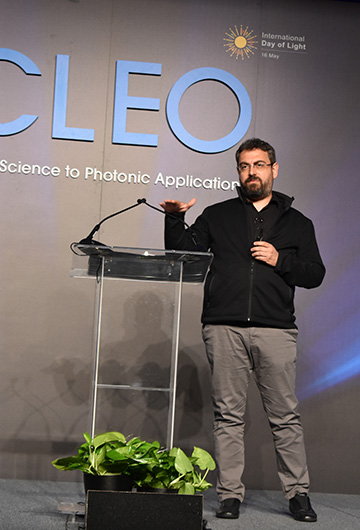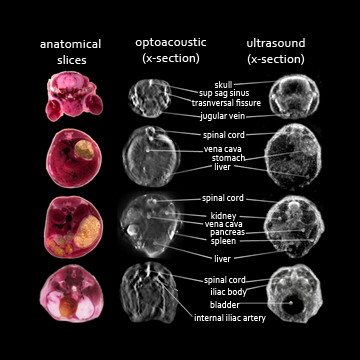
Vasilis Ntziachristos at CLEO 2018’s Tuesday morning plenary session.
In a wide-ranging plenary talk on the second day of the CLEO 2018 conference, Vasilis Ntziachristos, a research scientist at the Technical University of Munich, Germany, walked a capacity audience through the future of multispectral optoacoustic tomography (MSOT).
An imaging modality that can break through the photon-scattering barrier in biological tissues, MSOT is capable of producing some astonishingly high-res, seemingly razor-sharp images of internal bodily tissues at a variety of scales. Further, Ntziachristos’ talk made it clear that MSOT’s future is decidedly not limited to the research lab—with the technology moving increasingly toward clinical impact as well.
A clinical-translation focus
Before diving into MSOT, Ntziachristos spent a few minutes recounting the experience of a few non-MSOT imaging modalities his lab had worked on, to illuminate the clinical-translation process. Such clinical translation is, in fact, a key focus of Ntziachristos’ lab at Munich. “We develop our own systems, from scratch many times,” he said. And “we go all the way and perform our own clinical trials; we have the infrastructure to do this.”
Another focus, Ntziachristos said, is imaging techniques that can facilitate early detection of disease. “Early detection is very underappreciated,” he said, “both in research attention and funding. The best way to treat a lot of diseases is to treat them early.”
As an example, he pointed to earlier work from his lab in fluorescence imaging that was capable of identifying five times more cancerous areas in some tissues than the surgeon’s unaided eye, and a variant of which showed powerful advantages in detecting otherwise hard-to-find early-stage esophageal cancer. “We showed that compared to human vision, it’s much better to use the fluorescence to detect cancer,” said Ntziachristos. “The human eye is an optical detector, but it’s thousands of years old.”
The superiority of the fluorescence techniques allowed them to be spun out into a company, SurgView, that, Ntziachristos reports, was acquired three months ago by Bracco Imaging for conversion into clinical products. “We took an optical technology,” Ntziachristos said, “and we hope now to find it in operating rooms helping to deliver much more accurate surgery to patients worldwide.”
Going deeper with MSOT
The fluorescence techniques “have specificity and sensitivity—but they’re two-dimensional,” Ntziachristos noted. “We always want to go deeper.” Hence the interest in photoacoustic tomography, which can provide more detailed imaging deep in tissues, at a variety of length scales. The technique works by sending a laser pulse deep into the tissue to be imaged; interaction between the pulse and the tissue creates acoustic waves that can be read outside the body using an ultrasound detector, with propagation limited by ultrasonic rather than optical diffraction. “Instead of looking at light,” Ntziachristos said, “we’re listening to light.”
Indeed, Ntziachristos argues that his lab’s multispectral approach to photoacoustic tomography, MSOT, is a “six-dimensional modality.” The technique, he explains, covers not just the x, y, and z of space and the t of time, but also the fifth dimension of the spectral bands of the optical source, which respond to different levels of optical contrast in different tissues and substances, and thus allow the label-free imaging of multiple types of biomolecules.
And there’s a sixth dimension—the different frequencies of the ultrasound detector. You can engineer detectors that are ultra-wideband,” Ntziachristos said. “And that gives you very good resolution for individual structures” such as blood vessels and skin layers. (Splitting the ultrasound into smaller bands, he explained during a “meet-and-greet” session after the plenary, boosts the signal to noise ratio, “so that we can see the fine structures on top of the very strong signal from the low-frequency structures kind of mixing things together.”)
Striking detail

Comparison of results from MSOT and conventional ultrasound imaging. [Image: Wikimedia Commons/Ibmi munich]
The results, amply documented in the slides accompanying Ntziachristos’ talk, are strikingly detailed images that can illuminate and help diagnose inflammation, thyroid cancer, malignant melanoma, and metabolic and other conditions—all without the use of endogenous labeling agents. (Interpreting MSOT images, however, is still something of an art. “You can start generating some beautiful images,” Ntziachristos said, “but you have to be careful what these images mean.”)
The tests thus far, Ntziachristos believes, amply demonstrate the technique’s potential clinical value. And his team is working toward clinical translation, through creation and clinical testing of a handheld MSOT device and by developing techniques to put MSOT together with the workhorse technology of the biomedical clinic, the optical microscope.
Clinical enthusiasm
In the post-plenary meet-and-greet, Ntziachristos talked a bit more about the pathway for bringing MSOT into the clinic. “If you think about it, ultrasound has found so many applications,” he said, “and the only thing it gives is the three dimensions,” and maybe some time-based data. “It gives you some morphology, but that morphology is not very good.” The ability to add, to the well-known modality of ultrasound, the specificity of molecules through the optical channel, which allows one to read physiological conditions that ultrasound can’t see, is something that Ntziachristos says immediately resonates with end-user clinicians.
“A lot of the clinicians, when we talk with them, get very excited,” said Ntziachristos. “Because they never were able to see these things, they never thought this way.”
“They read our papers, and come to us with ideas” for possible applications, according to Ntziachristos. “That’s something that’s never happened before with the more traditional optical technologies. It happens all the time” for MSOT.
